A Face Above Another Face
Project name: A Face Above Another Face
January 2022 - April 2023
This project gave me the chance to research about my roots in Peru, and that has enriched not only the art world but also my own world. One of the most important results of this project was to be able to position myself, to understand from which position in the world I communicate through my art to the outside world. I took the project as a chance to deconstruct the thoughts and associations I have about the country where I was born and grew up, Peru. I observed my connections with others, with the diverse knowledges that co-habit there, and the antagonisms and polarizations in the social life of Peru. After all my travelling and reflections, my sculptural installations sow light for the stories repressed by coloniality, and with this I try to contribute to a symbolic reparation.
The dialogues developed with people in Peru, during this project, inspired and fascinated me. I admire now even more the resilience and spiritual power of people living under challenging circumstances. My own family from father side, who are living in the mountains, were a great source of inspiration. I had never seen them so deeply before due to my upbringing in the capital city, Lima. This project gave me the chance to work for the first time in Peru, as a professional artist, close to my father’s family. Although he passed away last year, just before the start of my project. I could still be near him in the heart through it. And at my return I developed a new insight about my work, about the need I have to heal through it and with it. I understand that that is one of my greatest motivation to make art.
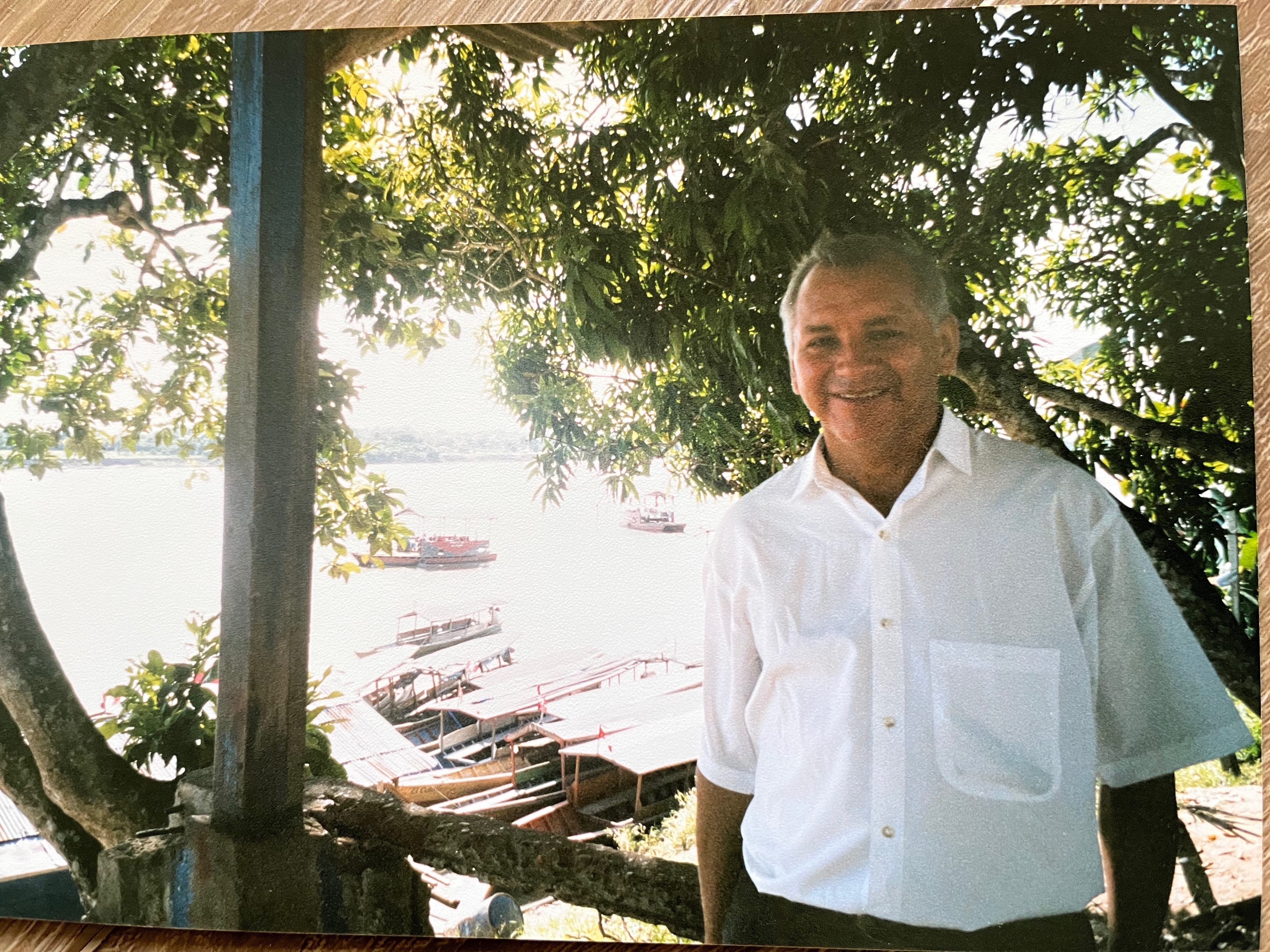
-photo of my father, year 2004
Activites:
- The year 2022 started with the development of my installation “An Education”. The installation parodies the way social systems teach how to stigmatise others. The work tries to mimic the system that, using the mass media, infiltrates within the multicultural household. For this I recreated the living room of my parents in Lima - Peru during my upbringing in the 80's. The big ceramic heads sitting on the sofa represent members of my family, including myself, watching TV content of that time, through a looping video I created. In the program poor people accepted racist comments, in order to gain some cents. And TV commercials sent messages about the ideal lifestyle, the definition of success and beauty, mostly represented by white people. Mass media sells this model as the ideal to a non-white population, creating in this way a social clash and frustration, but also a feeling of segregation and lack of acceptance in the native population.
The video also presents some parts of a very popular TV program of Saturday evening: "Trampolín a la Fama", in which poor people accepted to give a bad show and make ridicule in order to gain some cents. Here many discriminating attitudes are displayed, racist comments are made without filter, just to make the people laugh about their own pain.
This tv shows are part of my own upbringing in Peru, a beautiful country which still suffers from its colonial background. Because it was then that we learned to hate our color, our factions, hair and believes. We can't change the past, but we can change the present and the future. When we start valuing our ancestrality, we will start re-membering the power in us.
With this installation I want to make visible this system that has taught us how to stigmatise, discriminate and make inferior anyone who looks and talks as a native Peruvian. At the same time the inspiration in ancestral sculpture is a recognition to our past and a re-discovery of its potential.
To recreate my parents living room in the 80’s, I bought furniture and photo frames from a secondhand shop, and made “family photos” making the big ceramic heads represent the members of my family in the photo as well .
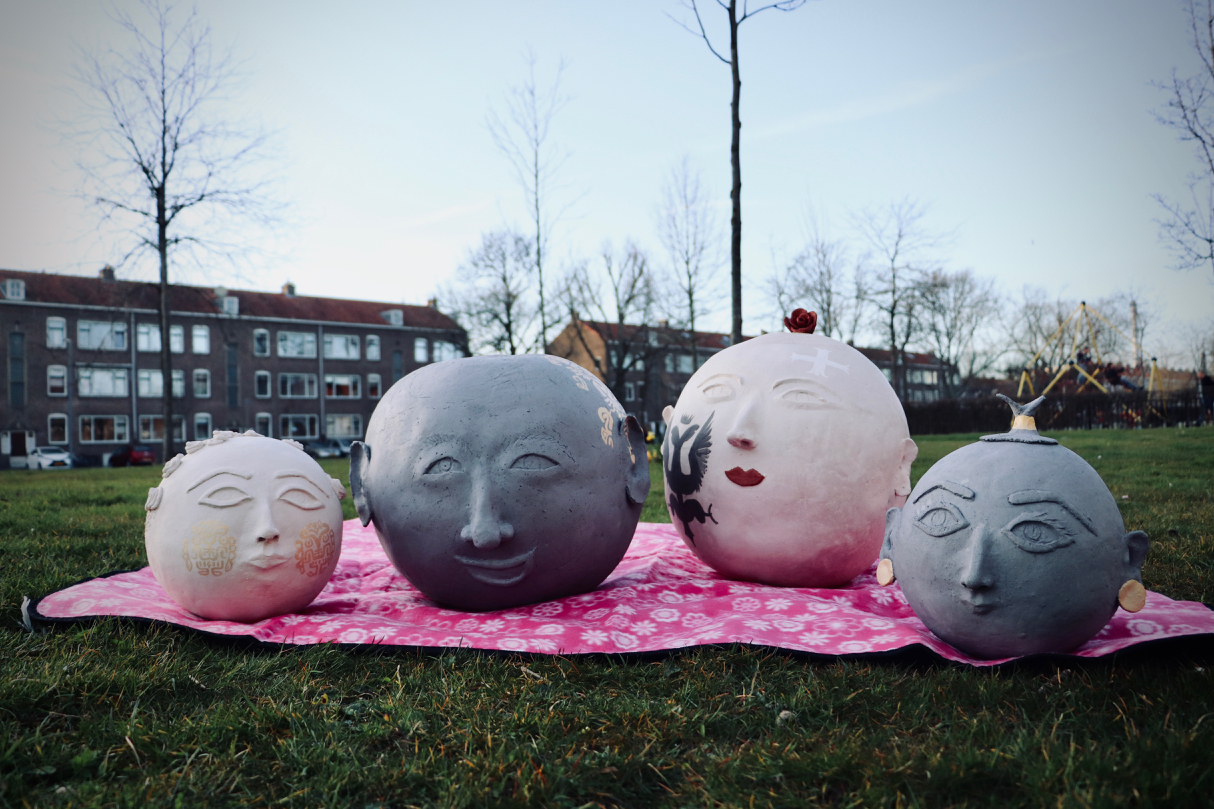
-A family photo I recreated with the portraits I made of my family.
For the ceramic masks hanging on one wall, I used my own face as a model, to represent the many society fears, dreams, types of oppression and invisibility. Some of the masks have a text on them. They are the adjectives of racial rejection, that I have experienced personally and that I confront in this work. The feelings proposed through the masks are inside the collective subconscious, sometimes I also experienced them in my identifications as a Peruvian. The masks work on the stereotypes that dehumanise the individual, by eliminating the multifaceted human experience and minimising it to just one association.
Coloniality makes that people do not want to associate themselves with their ancestrality, identities are confused by the association to a low self esteem caused by colonial systems, that deny the value of ancestral Peruvian knowledges. Colonial systems exploit and dehumanise to order and conquer.
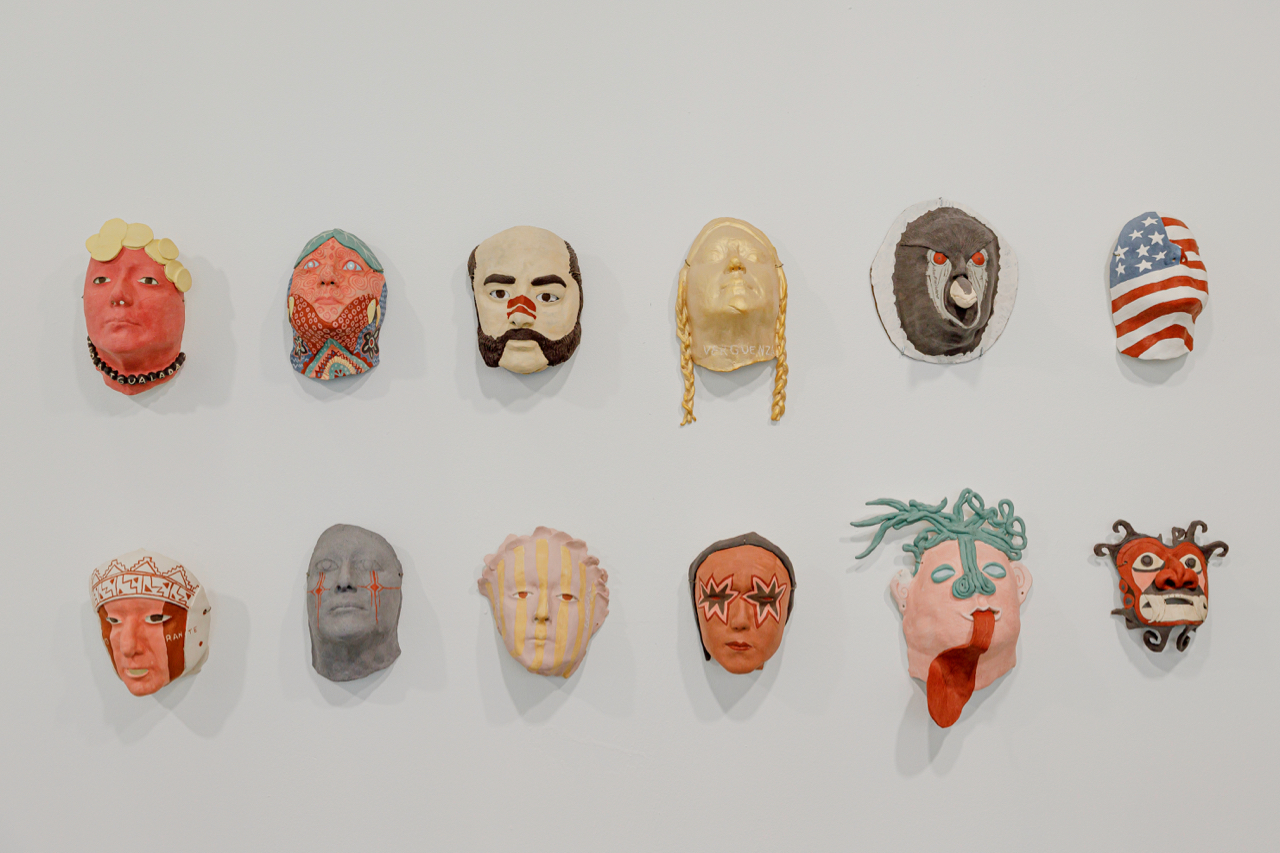
-photography by Les Adu.
A Peruvian middle class social convention is also observed in the installation, by mimicking the way of “sitting at home” within the middle and upper middle class family. The sculpture of a servant is sitting next to the sculpture of the house cat on the floor, on a lower physical position than the boss of the house. The public can engage, by sitting on the chairs or on the rug to watch the video.
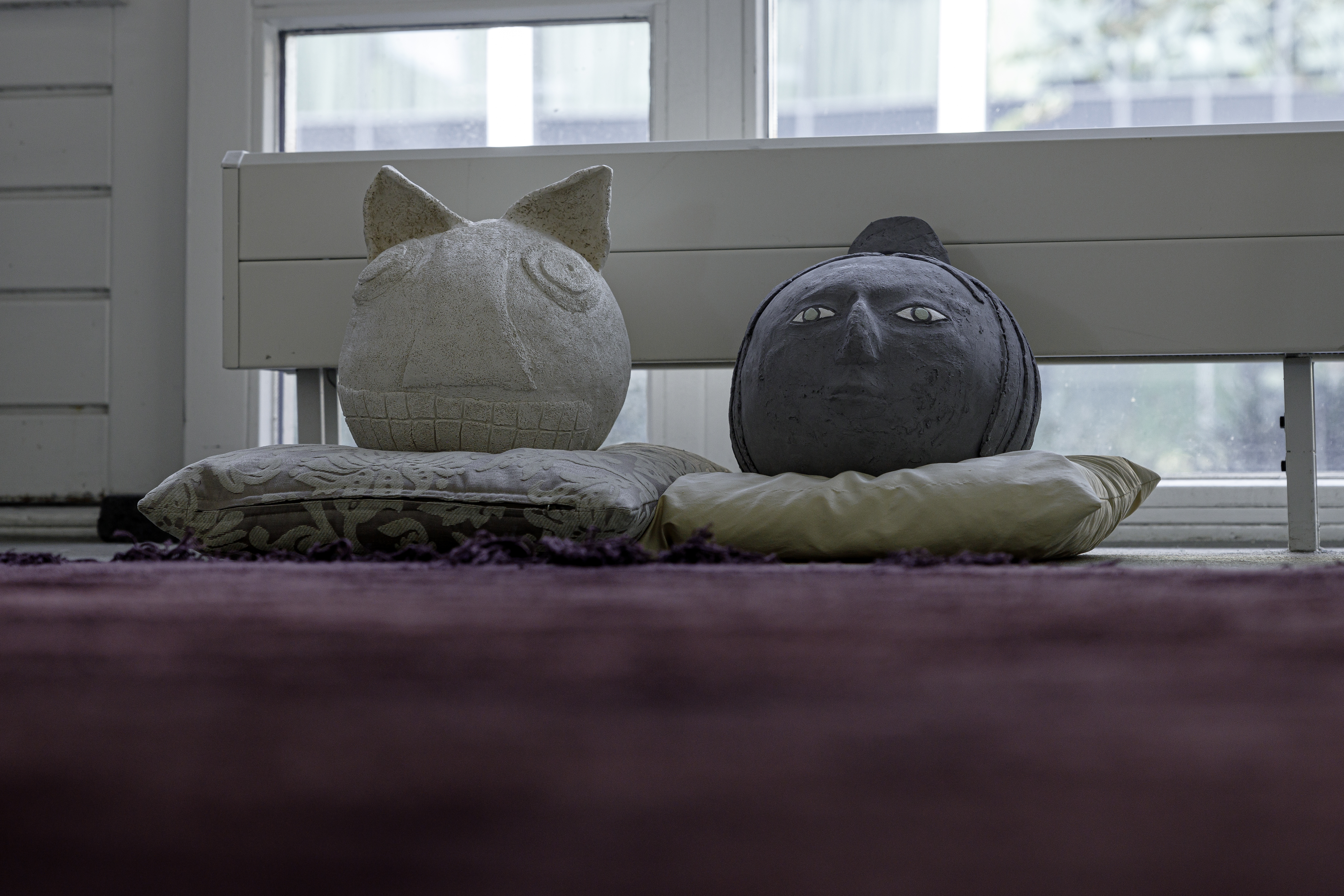
The work borrows inspiration from the ancestral Peruvian sculpture, such as Cabezas Clavas (stone heads) from Chavin culture and Mochica ceramics. Materials I used were stoneware, earthware and engobe. The big heads are 30 to 45 cm circumference. The masks are human face size.
- I presented this installation at CBK Zuidoost in March 2022, in a group exhibition proposed through the IANDE collective, from which I am part of. We co-curated the exhibition together with Renske De Jong, from CBK Zuidoost. The exhibition was called “A World Of Many Worlds”, and united the work of many Latin American artists living in Europe. A great article came out at the Groene Amsterdammer about it, with a long appreciative text about my work.
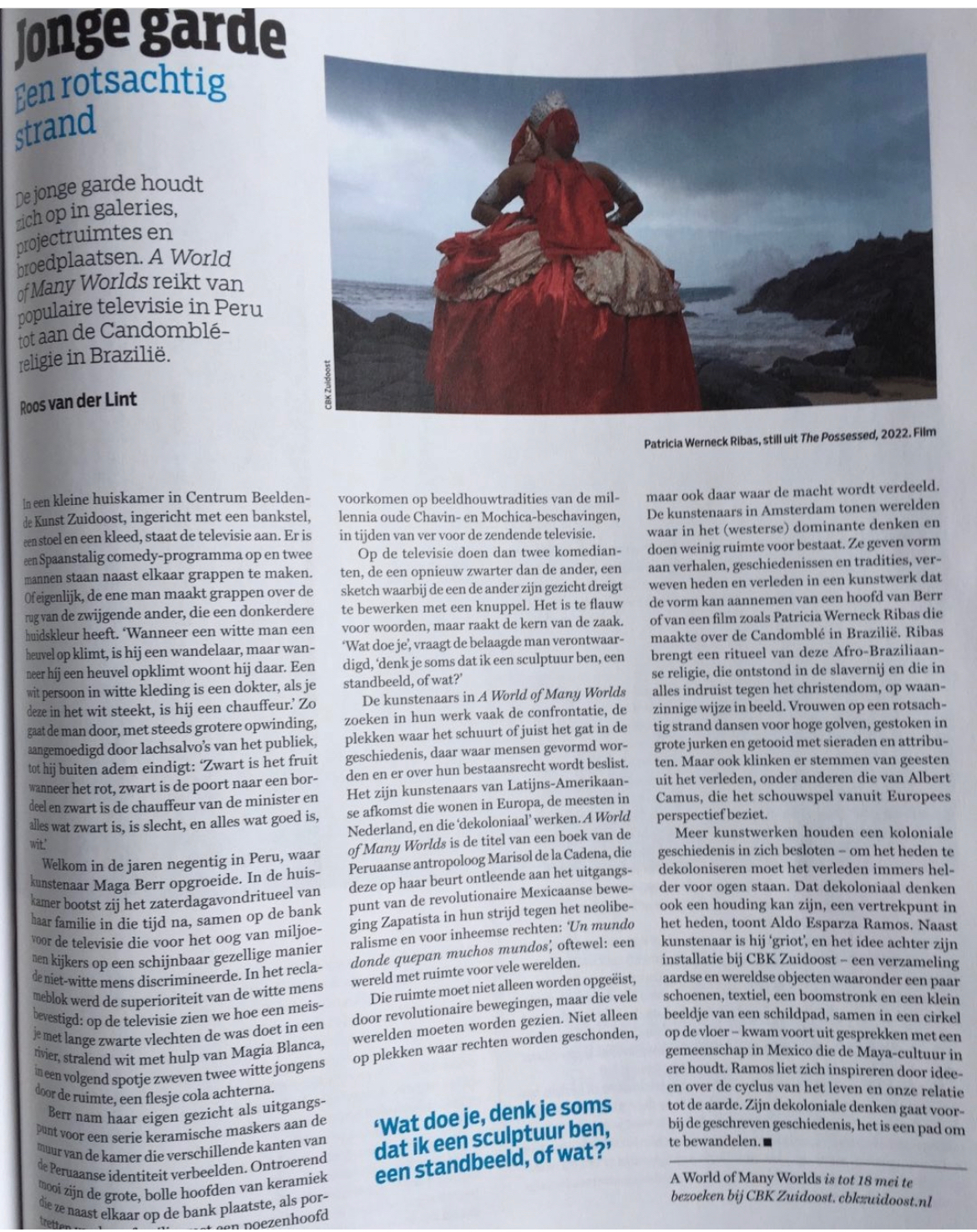
The group of exhibiting artists also gave an artist talk, for which external curators were invited and directed a dialogue about decoloniality, decolonial research, how to deal with our roots as Latin American artists who are resettled in Europe, strategies and challenges to develop decolonial art practices.
This show gave new ideas to our Iande collective, and we consolidated new exhibition plans for our group together with WM gallery in Amsterdam, who promised to provide us the space for an exhibition about our decolonial research for the following year 2023.
-
After this show, I travelled 4 times to Peru, in different occasions, alternating my life in the Netherlands and my project in Peru. I developed there my research about my roots and the my indigenous backgrounds that I wanted to rediscover. This brought me to a new experience about my country, which I hadn’t had before. In the mountains countryside, at the original birth place of my father, I lived like any other farmer would. I learned about the lifestyle and beliefs, ways of healing and cooking, ways of dealing with nature, much more sustainable than in westernised agriculture. At Lima city I learned about the Peruvian art world systems and decolonial artists discourse. At my return to the Netherlands, I wrote the two previous articles in my webblog, explaining the experience, and reflecting about the effect colonial mentality still has in the way we live together there and the way we treat each other. Colonial modernity means here the exploitation of all resources for a sort of imposed development model, which leads to a land in constant crisis; where racism increases poverty. There is also a huge contrast between the survival mode of many Peruvian citizens and the beauty of the country’s ancestral culture and mythology, the latter inspired my aesthetic choices much further.
-
All this reflections about coexistence in these two places is now reflected in my newest sculptural installation, called “Chicha Flow”, which was presented during Art Rotterdam 2023, at Prospects exhibition organised by the Mondriaan Fund.

Chicha is a drink made of corn, but the word also means multiculturality in Peru. It refers to the cultural mix of the Andean Cosmovision with the values of the Western city. The sculptural installation is made with ceramics, and experiments with glazing materials such as oxides, pigments, engobe and glaze of course.
The installation explores the diverse Peruvian identities related to the interaction with nature and spirituality, the challenges of cultural diversity; and the sociopolitical situation in the country which requires resilience of the people. The work is also an homage to the ceramic tradition that exists in Peru. I got inspiration from the Mochica ceramics, Chavin sculpture, and the Inca mythology and aesthetics. But also from classic European sculpture, which I always studied on books during my upbringing in Peru.
Within the installation diverse microcosmos are communicating to each other about the mythical, abundant but also polarized land Peru can be. Power relations within human interactions can be observed in the intersectionality between race, class and gender. Here we witness an imbalance and unfairness born in colonial contexts, that have prevaled during the centuries and is still reproduced through diverse institutions like the church, and mass media. Masks show conglomerations of meanings and contradictions of this complex society, where a deep feeling of sadness about the wound inflicted in ancestral past stays as a sickness that spreads around with expressions of shame about being a native. The ancestral and the modern, nature and nurture, native beliefs and catholicism are clashing within masks and in the whole installation.
The table with legs speaks about the effects of globalisation in the local economy. Street vendors are always together with their product, from early morning to late at night, they become inseparable. This is why this table sculpture tries to become human, and become anthropomorphic. The table represents the street vendors combination with its products, as one thing. The table speaks about the vulnerable lives full of color, surprises, struggle and stones. Carrying a world, a mix of local produce and industrial global foods, the table is representing the most resilient characteristic of the Peruvian population.
The table made of stoneware carries a mix of street vendors products and ceramic corn, potatoes and stones I made. I used pigments, oxides and glaze to give color. The table size is 57x46 cm, by 46 cm high.
I also built a tribute to mother earth, who feeds us. At the same time the sculpture is a statement about the divine abundance that women can bring to life. Mother Earth is a woman and a mountain who gives birth. Human being and the earth become one, just as it happens in the Andean worldview. The sculpture is made in stoneware, the main part is glazed with copper oxide, the hanging parts have golden engobe, manganese oxide and transparent glaze. It has some plants growing and added shells. It measures 130 cm high by around 65 cm diameter at the bottom side.
For making it I got inspiration from the profound relationship with mother earth in Peru. The soil is there very fertile and many of the products we find in our western supermarkets come from there. There are many rituals to show thankfulness to mother earth in Peru. At the same time, women feed the community by passing the ancestral wisdom about nature. The passing of knowledge from generation to generation makes the culture survive.
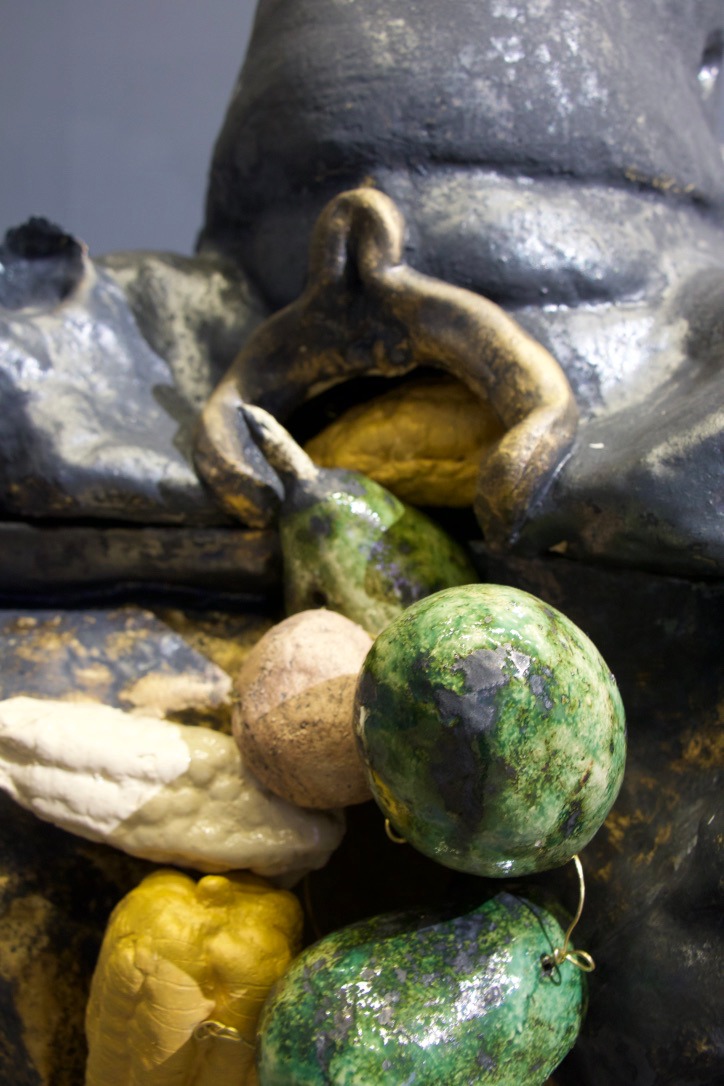
There is also the new conception of the God Wiracocha, the Sun god of the Incas, represented in my installation as a head inside a scale.“…Wiracocha, she created lakes with her tears. From lakes rivers were born, and then we could grow food, and thanks to that we became stronger. No tear was wasted in this world…”
This is my own version of Wiracocha, who according to mainstream history books, was a male god of pre-Inca times in Abya Yala (Latin America in native language). Wiracocha exists in the Andean myths about creation. But after colonial times it was humanized and made white. History is always written by the winners. This time I made my own version, this god is now female. For this piece I got inspiration from pre-Inca mythological study, and it became a symbolic reparation of colonial historical narratives.
- Together with my colleagues of Iande artistic collective, we presented the latest work we have developed as part of our decolonial research, at our exhibition “Yamitata’s Untold Stories” at WM gallery in Amsterdam, running from 24 March till April 22, 2023. Stories in Latin America, which were once repressed by colonial modernity, get voice and body in our artistic narratives.
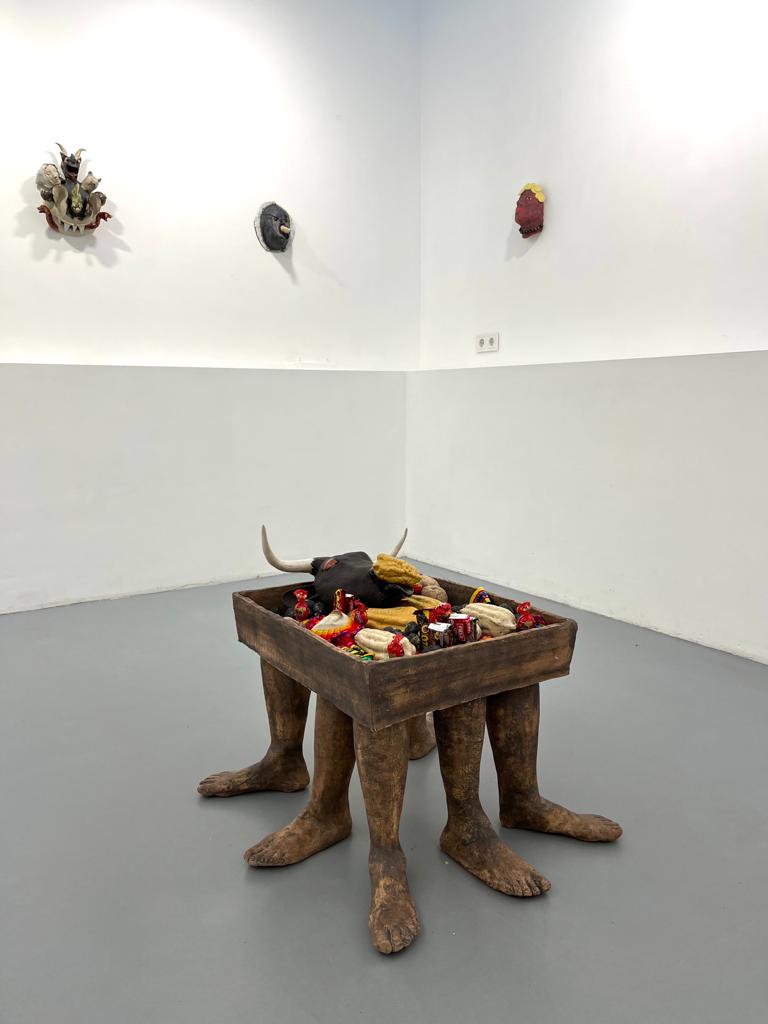
-Photo of part of my installation presented at WM gallery